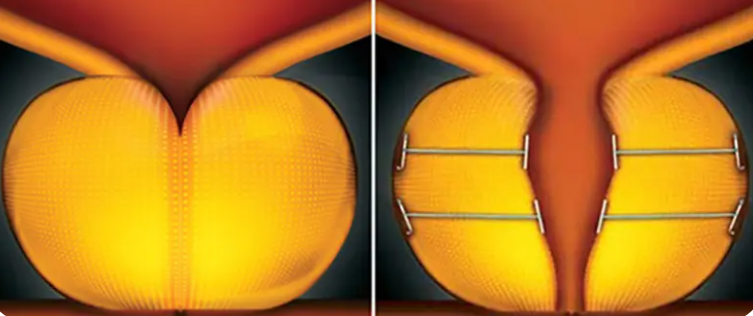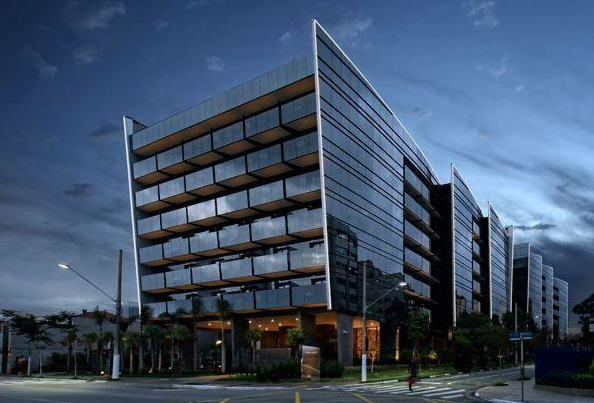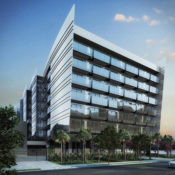Index
Introduction
UroLift as a Minimally Invasive Treatment Option for BPH
Benign Prostatic Hyperplasia (BPH) is a common condition affecting many men as they age, leading to an enlarged prostate, and consequently causing uncomfortable symptoms and impacting the quality of life. UroLift is a minimally invasive treatment that offers an alternative to traditional treatments for BPH, such as medications or more invasive surgeries.
Symptoms of Benign Prostatic Hyperplasia (BPH)
BPH can cause various symptoms that disrupt patients’ routines, including:
- Difficulty starting urination
- Weak or interrupted urine stream
- Feeling of incomplete bladder emptying
- Need to urinate frequently, especially at night (nocturia)
- Urgency to urinate
- Urinary incontinence
These symptoms can be bothersome and significantly affect the quality of life for patients. UroLift aims to treat BPH by alleviating these symptoms and improving urinary flow.
How UroLift Relieves BPH Symptoms
UroLift is a procedure that uses small implants to push aside the sides of the prostate, relieving pressure on the urethra and allowing urine to flow more freely. The treatment does not involve the removal of prostate tissue, which means there are fewer risks of complications and side effects compared to other surgical treatments.
By opting for UroLift, patients can experience significant improvements in BPH symptoms, such as reduced frequency and urgency of urination and increased urinary flow. Furthermore, UroLift has the advantage of being a less invasive procedure with fewer side effects, preserving sexual function and ensuring a faster recovery.
Why Consider UroLift for Treating BPH
UroLift is an attractive treatment option for patients seeking relief from BPH symptoms without resorting to more invasive treatments or those that could impact sexual function. Additionally, the swift post-operative recovery allows patients to return to their regular activities in a short time, minimizing the impact of the treatment on their daily lives.
What is UroLift and how does it work?
The UroLift Procedure
UroLift is an innovative and minimally invasive treatment for Benign Prostatic Hyperplasia (BPH). The procedure involves placing permanent implants that help relieve the obstruction caused by the enlarged prostate. During the surgery, the urologist uses a specialized device to insert the implants through the urethra.
The doctor begins by inserting a thin and flexible endoscope into the urethra, allowing for direct visualization of the prostate. Then, the doctor positions the UroLift implants in the appropriate location to push the sides of the prostate apart, reducing pressure on the urethra and improving urinary flow. The procedure typically takes about an hour and can be performed under local or general anesthesia, depending on the preferences of the patient and the doctor.
What to Expect During and After the Surgery
During the surgery, patients may experience some discomfort, but anesthesia will help minimize pain. After the procedure, patients can expect a relatively quick recovery. Some people may experience mild to moderate pain, discomfort, or bleeding in the urine for a short period after the surgery. These symptoms usually fade within a few days.
Most patients can return to regular activities within a few days after the procedure but should avoid strenuous activities for about two weeks. The doctor will provide specific guidelines for each patient regarding when to return to work and other daily activities.
Results from UroLift are generally noticeable within two weeks, with significant improvements in BPH symptoms and quality of life. However, it’s important to remember that every patient is unique, and results can vary.
Benefits of UroLift
UroLift offers several advantages compared to other treatment options for BPH, including:
- Preservation of Sexual Function: One of the main advantages of UroLift is the preservation of sexual function. Since the procedure doesn’t involve the removal of prostate tissue or changes to anatomy, the risk of erectile dysfunction and retrograde ejaculation is significantly lower compared to other surgeries for BPH.
- Quick Postoperative Recovery: Due to the minimally invasive nature of the procedure, patients generally recover faster after UroLift than after more invasive surgeries. Most patients can resume their regular daily activities in just a few days, reducing the impact of treatment on everyday life.
- Fewer Side Effects and Complications: UroLift poses fewer risks and side effects compared to other surgical treatment options for BPH. Apart from preserving sexual function, patients also have a reduced risk of urinary tract infections, urethral stricture, and urinary incontinence.
- Lasting Symptom Relief: UroLift provides long-lasting relief from BPH symptoms, with studies showing consistent results for up to five years after the procedure. This means patients can expect a significant improvement in quality of life and a reduction in urinary symptoms.
- No Need for Continuous Medication: After UroLift, many patients can stop or reduce their BPH medications. This can be a significant advantage for patients experiencing side effects from medicines or those who wish to avoid ongoing medication use.
- Outpatient Procedure: UroLift is an outpatient procedure, meaning patients typically don’t require hospital admission. This makes the treatment more convenient and less costly compared to some more invasive surgeries that necessitate hospitalization.
UroLift Price
Factors influencing the price of UroLift
The cost of the UroLift procedure can vary considerably depending on several factors. Some of the main elements that can affect the price include:
- Geographic Location: The cost of UroLift may be influenced by the region in which you live and by the supply and demand of urologists in the area. Generally, costs in metropolitan areas or large cities may be higher than in less populated regions.
- Doctor’s Experience: The experience and reputation of the urologist performing the procedure can also affect the price. Doctors with greater experience and reputation in the field may charge more for their services.
- Facilities and Equipment: The type of facility where the procedure is conducted and the quality of the equipment used can also influence the cost of UroLift. Private clinics and hospitals with cutting-edge technology may have higher costs than less sophisticated facilities.
Price Variation and the Importance of Consulting a Qualified Doctor
Due to the variation in the factors mentioned above, it’s crucial for patients to consult a qualified urologist, such as Dr. Petronio Melo, to get an accurate estimate of the UroLift procedure’s cost. During the consultation, the doctor will assess your condition and discuss treatment options, including UroLift, based on your specific needs and financial circumstances.
It’s essential to remember that the cost should not be the only factor considered when deciding on BPH treatment. The doctor’s experience and skill, as well as the procedure’s efficacy and safety, are critical aspects to take into account.
Comparison with Other Treatment Options
When considering treatment for Benign Prostatic Hyperplasia (BPH), it’s important to understand the various options available and how they compare to UroLift. In this section, we will discuss medications, open surgery, and laser therapy, comparing their advantages and disadvantages in terms of effectiveness, risks, side effects, and costs.
Medications
Medications are often the first line of treatment for patients with BPH. There are two main types of drugs used to treat BPH: alpha-blockers and 5-alpha-reductase inhibitors.
- Alpha-blockers: These medications help relax the muscles of the prostate and the bladder neck, improving urinary flow. Common alpha-blockers include tamsulosin, terazosin, doxazosin, and alfuzosin.
- 5-alpha-reductase inhibitors: These medications reduce the size of the prostate by decreasing the amount of dihydrotestosterone (DHT) hormone in the body. The most common 5-alpha-reductase inhibitors include finasteride and dutasteride.
Advantages of Medications:
- Non-invasive treatment
- Generally lower cost compared to surgical procedures
- Symptom relief in many patients
Disadvantages of Medications:
- May take weeks or months to take effect
- Side effects, such as dizziness, fatigue, erectile dysfunction, and decreased libido
- Need for long-term medication
- Efficacy may decrease over time
Open Surgery
Open surgery, also known as open prostatectomy or transurethral resection of the prostate (TURP), is a treatment option for BPH patients whose symptoms don’t improve with medications or less invasive therapies. During open surgery, the surgeon removes prostate tissue that is blocking the urinary flow through the urethra.
Advantages of Open Surgery:
- Effective treatment for severe BPH cases or when other options fail
- Long-lasting symptom relief in many patients
- Significant improvement in urinary flow
Disadvantages of Open Surgery:
- Invasive procedure with a higher risk of complications
- Longer recovery time compared to other treatment options
- Risk of infection, bleeding, urinary incontinence, and erectile dysfunction
- Higher cost compared to medications and some other procedures
Laser Therapy
Laser therapy is a minimally invasive treatment option that uses laser energy to remove or vaporize prostate tissue that’s blocking urinary flow. There are several laser therapy techniques, including photoselective vaporization of the prostate (PVP) and holmium laser enucleation of the prostate (HoLEP).
Advantages of Laser Therapy:
- Minimally invasive procedure
- Lower risk of bleeding compared to open surgery
- Faster recovery than open surgery
- May be an option for patients who can’t undergo open surgery due to high surgical risks
Disadvantages of Laser Therapy:
- Higher cost compared to medications and sometimes more expensive than UroLift
- Risk of side effects, such as pain, urinary infection, temporary urinary incontinence, and erectile dysfunction
- Not all patients are candidates for laser therapy, depending on the size and anatomy of the prostate
Comparison with UroLift
When comparing UroLift to other treatment options, it’s important to consider the following factors:
- Effectiveness: UroLift is an effective treatment option for many BPH patients, especially those with smaller prostates and moderate symptoms. However, in cases of very large prostates or severe symptoms, open surgery or laser therapy might be more effective.
- Risks and Side Effects: UroLift has a more favorable risk profile compared to open surgery and laser therapy, with a lower risk of complications and side effects such as erectile dysfunction and urinary incontinence.
- Cost: While UroLift may be more expensive than medications, its cost is generally lower than open surgery and laser therapy. Additionally, UroLift might be covered by health insurance and financing options, making it more affordable for many patients.
- Recovery: Recovery after UroLift is generally faster than after open surgery and, in some cases, faster than after laser therapy. This allows patients to return to their regular activities more quickly.
When choosing the most suitable treatment option for BPH, it’s crucial to consult a qualified urologist who can assess your specific situation and recommend the most appropriate treatment.
Conclusion
The Importance of BPH Treatment
Treating Benign Prostatic Hyperplasia (BPH) is vital to ensure the quality of life and overall health of patients affected by this condition. BPH can lead to serious complications if not adequately addressed, such as urinary tract infections, acute urinary retention, and damage to the kidneys. Moreover, BPH symptoms can significantly impact daily life, causing discomfort and frequent disruptions to normal activities.
UroLift is a minimally invasive and effective treatment option for many patients with BPH, providing symptom relief and preserving sexual function. With its swift post-operative recovery and lower risk of complications compared to other treatment options, UroLift might be the ideal choice for many patients seeking a lasting solution to BPH symptoms.
In conclusion, UroLift is a promising and minimally invasive treatment option for Benign Prostatic Hyperplasia, offering significant benefits compared to other treatment alternatives. With its proven efficacy, fast recovery, and preservation of sexual function, UroLift may be the ideal solution for many patients facing the challenges of BPH. Contact us today to learn more and take the first step towards a more comfortable and healthy life.





